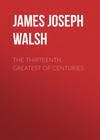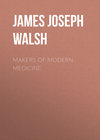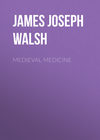Loe raamatut: «The Thirteenth, Greatest of Centuries», lehekülg 37
APPENDIX III.
CRITICISMS, COMMENTS, DOCUMENTS
HUMAN PROGRESS
For most people the impossible would apparently be accomplished if a century so far back as the Thirteenth were to be even seriously thought of as the greatest of centuries. Evolution has come to be accepted so unquestioningly, that of course "we are the heirs of all the ages of the foremost files of time," and must be far ahead of our forbears, especially of the distant past, in everything. When a man talks glibly about great progress in recent times, he usually knows only the history of his own time and not very much about that. Men who have studied other periods seriously hesitate about the claim of progress, and the more anyone knows about any other period, the less does he think of his own as surpassing. There are many exemplifications of this in recent literature. Because this was a cardinal point in many criticisms of the book, it has seemed well to illustrate the position here taken as to the absence of progress in humanity by quotations from recognized authorities. Just as the first edition of this book came from the press, Ambassador Bryce delivered his address at Harvard on "What is Progress?" It appeared in the Atlantic Monthly for August, 1907. Mr. Bryce is evidently not at all persuaded that there is human progress in any real sense of the word. Some striking quotations may be made from the address, but to get the full impression of Mr. Bryce's reasons for hesitation about accepting any progress, the whole article needs to be read. For instance, he said:
"It does not seem possible, if we go back to the earliest literature which survives to us from Western Asia and Southeastern Europe, to say that the creative powers of the human mind in such subjects as poetry, philosophy, and historical narrative or portraiture, have either improved or deteriorated. The poetry of the early Hebrews and of the early Greeks has never been surpassed and hardly ever equaled. Neither has the philosophy of Plato and Aristotle, nor the speeches of Demosthenes and Cicero. Geniuses like Dante, Chaucer, and Shakespeare appear without our being able to account for them, and for aught we know another may appear at any moment. It is just as difficult, if we look back five centuries, to assert either progress or decline in painting. Sculpture has never again risen to so high a level as it touched in the fifth century, B. C, nor within the last three centuries, to so high a level as it reached at the end of the fifteenth. But we can found no generalizations upon that fact. Music is the most inscrutable of the arts, and whether there is any progress to be expected other than that which may come from a further improvement in instruments constituting an orchestra, I will not attempt to conjecture, any more than I should dare to raise controversy by inquiring whether Beethoven represents progress from Mozart, Wagner progress from Beethoven."
Perhaps the most startling evidence on this subject of the absence of evolution in humanity is the opinion of Prof. Flinders Petrie, the distinguished English authority on Egyptology, who has added nearly a millennium to the history of Egypt. His studies have brought him in intimate contact with Egypt from 2,000 to 5,000 B. C. He has found no reason at all for thinking that our generation is farther advanced in any important qualities than men were during this period. In an article on "The Romance of Early Civilization" (The Independent, Jan. 7, 1909), he said:
"We have now before us a view of the powers of man at the earliest point to which we can trace written history, and what strikes us most is how very little his nature or abilities have changed in seven thousand years; what he admired we admire; what were his limits in fine handiwork also are ours. We may have a wider outlook, a greater understanding of things; our interests may have extended in this interval; but so far as human nature and tastes go, man is essentially unchanged in this interval." … "This is the practical outcome of extending our view of man three times as far back as we used to look, and it must teach us how little material civilization is likely in the future to change the nature, the weaknesses, or the abilities of our ancestors in ages yet to come."
Those who think that man has advanced in practical wisdom during the 6,000 years of history, forget entirely the lessons of literature. Whenever a great genius has written, he has displayed a knowledge of human nature as great as any to be found at any other time in the world's history. The wisdom of Homer and of Solomon are typical examples. Probably the most striking evidence in this matter is to be found in what is considered to be the oldest book ever written. This is the Instructions of Ptah Hotep to his son. Ptah Hotep was the vizier of King Itosi, of the Fifth Dynasty of Egypt (about 3650 B.C.). There is nothing that a father of the modern time would wish to tell his boy as the result of his own experience that is not to be found in this wise advice of a father, nearly 6,000 years ago. This was written longer before Solomon than Solomon is before us, yet no practical knowledge to be gained from intercourse with men has been added to what this careful father of the long ago has written out for his son.
THE CENTURY OF ORIGINS
To many readers apparently, it has seemed that the main reason for writing of The Thirteenth as the Greatest of Centuries was the fact that the Church occupied so large a place in the life of that time, and that, therefore, most of what was accomplished must naturally revert to her account. It is not only those who are interested in the old Church, however, who have written enthusiastically about the Thirteenth Century. Since writing this volume, I have found that Mr. Frederick Harrison is almost, if not quite, as ardent in his praise of it as I have been. There are many others, especially among the historians of art and of architecture, who apparently have not been able to say all that they would wish in admiration of this supreme century. Most of these have not been Catholics; and if we place beside Mr. Frederick Harrison, the great Positivist of our generation, Mr. John Morley, the great Rationalist, the chorus of agreement on the subject of the greatness of the Thirteenth Century ought to be considered about complete. Mr. Morley, in his address on Popular Culture, delivered as President of the Midland Institute, England, October, 1876 (Great Essays. Putnam, New York), said:
"It is the present that really interests us; it is the present that we seek to understand and to explain. I do not in the least want to know what happened in the past, except as it enables me to see my way more clearly through what is happening to-day. I want to know what men thought and did in the Thirteenth Century, not out of any dilettante or idle antiquarian's curiosity, but because the Thirteenth Century is at the root of what men think and do in the nineteenth."
EDUCATION
Many even of the most benevolent readers of the book have been quite sure that it exaggerated the significance of medieval education and, above all, claimed too much for the breadth of culture given by the early universities. Prof. Huxley is perhaps the last man of recent times who would be suspected for a moment of exaggerating the import of medieval education. In his Inaugural Address on Universities Actual and Ideal, delivered as Rector of Aberdeen University, after discussing the subject very thoroughly, he said:
"The scholars of the Medieval Universities seem to have studied grammar, logic and rhetoric; arithmetic and geometry; astronomy, theology and music. Thus their work, however imperfect and faulty, judged by modern lights, it may have been, brought them face to face with all the leading aspects of the many-sided mind of man. For these studies did really contain, at any rate in embryo, sometimes it may be in caricature, what we now call philosophy, mathematical and physical science, and art. And I doubt if the curriculum of any modern university shows so clear and generous a comprehension of what is meant by culture, as this old Trivium and Quadrivium does." (Italics ours.)
The results of this system of education may be judged best perhaps from Dante as an example. In The Popes and Science (Fordham University Press, N. Y., 1908) a chapter is devoted to Dante as the typical university man of the time, above all in his knowledge of science as displayed in his great poem. No poet of the modern time has turned with so much confidence to every phase of science for his figures as this product of medieval universities. Anyone who thinks that the study of science is recent, or that nature study was delayed till our day, need only read Dante to be completely undeceived.
The fact that the scholars and the professors at the universities were almost without exception believers in the possibility of the transmutation of metals in the old days, used to be considered by many educated people as quite sufficient to stamp them as lacking in judgment and as prone to believe all sorts of incredible and even impossible things without justification. Such supercilious condemnation of the point of view of the medieval scholars in this matter, however, has recently received a very serious jolt. Sometime ago, Sir William Ramsey, the greatest of living English chemists, announced at the meeting of the British Association for the Advancement of Science, that he had succeeded in changing copper into lithium. This created a sensation at the time, but represented, after all, a culmination of effort in this direction that had long been expected. More recently, Sir William has reported to the British Chemical Society that he has succeeded in obtaining carbon from four substances not containing this element—bismuth, hydro-fluo-silicic acid, thorium and zirconium. An American professor of chemistry has declared that he would like to remove all traces of silver from a quantity of lead ore, and then, after allowing it to stand for some years, have the opportunity to re-examine it, since he is confident that he would find further traces of silver in it that had developed in the meantime. He is sure that the reason why these two metals always occur together, as do copper and, gold, is that they are products of a developmental process, the precious metals being a step farther on in that process than the so-called base metals. It would seem, then, that the medieval scholars were not so silly as they used to appear before we knew enough about the subject to judge them properly. Only their supercilious critics were silly.
It is probably with regard to the exact sciences that most even educated people are quite sure that the Thirteenth Century does not deserve to be thought of as representing great human advance. For them the Middle Ages were drowsily speculative, but never exact in thinking. Of course, such people know nothing of the intense exactness of thought of St. Thomas or Albertus Magnus or Duns Scotus. It would be impossible, moreover, to make them realize, from the writings of these men, how exact human thought actually was in the Thirteenth Century, though the more that modern students devote themselves to scholastic philosophy, the more surely do they appreciate and admire this very quality in the medieval philosophy. For such people, very probably, the only evidence that would have made quite an adequate answer to their objection, would be a chapter on the mathematics of the Thirteenth Century. That might very easily have been made, for Cantor, in his History of Mathematics (Vorlesungen Über Geschichte der Mathematik, Leipzig, 1892), devotes nearly 100 pages of his second volume to the mathematicians of the Thirteenth Century, two of whom, Leonardo of Pisa and Jordanus Nemorarius, did so much in Arithmetic, the Theory of Numbers, Algebra and Geometry, as to make a revolution in mathematics. Cantor says that they accomplished so much, that their contemporaries and successors could scarcely follow them, much less go beyond them. They had great disciples, like John of Sacrobusco (probably John of Holywood, near Dublin), Joannes Campanus and others. Cantor calls attention particularly to the spread of arithmetical knowledge among the masses, which is a well-deserved tribute to the century, for it was a characteristic of the time that the new thoughts and discoveries of scholars were soon made practical and penetrated very widely among the people. Brewer, in the Preface to Roger Bacon's works, quotes some of Bacon's expressions with regard to the value of mathematics. The English Franciscan said: "For without mathematics, nothing worth knowing in philosophy can be attained." And again: "For he who knows not mathematics cannot know any other science; what is more, he cannot discover his own ignorance or find its proper remedy." The term mathematics, as used by Bacon, had a much wider application then than now, and Brewer notes that the Thirteenth Century scientist included therein Geometry, Arithmetic, Astronomy, and Music.
With regard to post-graduate education; the best evidence that, far from any exaggeration of what was accomplished in the Thirteenth Century, there has been a very conservative estimate of it made in the book, may be gathered from the legally erected standards of the medical schools and the legal status of the medical profession. In the Appendix of The Popes and Science, two Bulls are published, issued by Pope John XXII. (Circa, 1320), establishing medical schools in Perugia, at that time in the Papal States, and in Cahors, the birthplace of this pope. These bulls were really the formal charters of the medical schools. They require three years of preliminary study at the university and four or five years at medicine before the degree of doctor may be granted, and in addition emphasized that the curricula of the new medical schools must be equal to those of Paris and Bologna. These bulls were issued in the early part of the fourteenth century, and show the height to which the standards of medical education had been raised. There will be found also a law of Frederick II., issued 1241, requiring for all physicians who wished to practice in the Two Sicilies three years of preliminary study—four years at the medical school and a year of practice with a physician before the diploma which constituted a license to practice would be issued. This law is also a pure drug law forbidding the sale of impure drugs under penalty of confiscation of goods, and the preparation of them under penalty of death. Our pure drug law was passed about the time of the issue of the first edition of this book.
Those who ask for the results of this post-graduate training may find them in the story of Guy de Chauliac, the Father of Modern Surgery. His life formed the basis of a lecture before the Johns Hopkins Medical Club that is to be published in the Bulletin of John Hopkins Hospital. It is incorporated in Catholic Churchmen in Science, Second Series (The Dolphin Press, Phila., 1909). We know Chauliac's work not by tradition, but from his great text-book on surgery. This great Papal physician of the fourteenth century operated within the skull, did not hesitate to open the thorax, sewed up wounds of the intestines, and discussed such subjects as hernia, catheterization, the treatment of fractures, and manipulative surgery generally with wonderful technical ability. His book was the most used text-book for the next two centuries, and has won the admiration of everyone who has ever read it.
TECHNICAL EDUCATION OF THE MASSES
Some of my friends courteously but firmly have insisted with me that I have greatly exaggerated the technical abilities of the village workmen of the Middle Ages. That every town of less than ten thousand inhabitants in England was able to supply such workmen as we can scarcely obtain in our cities of a million inhabitants, and in that scanty population supply them in greater numbers than we can now secure them from our teeming populations, seems to many simply impossible.
What I have been trying to say, however, in the chapters on the Arts and Crafts and on Popular Education, has been much better said by an authority that will scarcely be questioned by my critics. The Rev. Augustus Jessopp, D. D., who has been for twenty years the Rector of Searning in England, who is an Honorary Fellow of St. John's College and of Worcester College, Oxford, besides being an Honorary Canon in the Cathedral of Norwich, has devoted much time and study to this question of how the cathedrals were built and finished. Twenty years of his life have been spent in the study of the old English parish and of parish life. He has studied the old parish registers, and talks, therefore, not from distant impressions, but from the actual facts as they are recorded. If to his position as an antiquarian authority I add the fact that he is not a member of the Roman Catholic Church, to the credit of which so much of this popular education and accomplishment in the arts and crafts of the century accrues, the value of his evidence is placed entirely above suspicion of partisan partiality. In his chapter on Parish Life in England, in his book "Before the Great Pillage" (Before the Great Pillage with other Miscellanies, by Augustus Jessopp, D. D., London. T. Fisher Unwin, Paternoster Square, 1901), he says:
"The evidence is abundant and positive, and is increasing upon us year by year, that the work done upon the fabrics of our churches, and the other work done in the beautifying of the interior of our churches, such as the woodcarving of our screens, the painting of the lovely figures in the panels of those screens, the embroidery of the banners and vestments, the frescoes on the walls, the engraving of the monumental brasses, the stained glass in the windows, and all that vast aggregate of artistic achievements which existed in immense profusion in our village churches till the sixteenth century stripped them bare—all this was executed by local craftsmen. The evidence for this is accumulating upon us every year, as one antiquary after another succeeds in unearthing fragments of pre-Reformation church-wardens' accounts.
"We have actual contracts for church building and church repairing undertaken by village contractors. We have the cost of a rood screen paid to a village carpenter, of painting executed by local artists. We find the name of an artificer, described as aurifaber, or worker in gold and silver, living in a parish which could never have had five hundred inhabitants; we find the people in another place casting a new bell and making the mould for it themselves; we find the blacksmith of another place forging the iron work for the church door, or we get a payment entered for the carving of the bench ends in a little church five hundred years ago, which bench ends are to be seen in that church at the present moment. And we get fairly bewildered by the astonishing wealth of skill and artistic taste and aesthetic feeling which there must have been in this England of ours, in times which till lately we had assumed to be barbaric times. Bewildered, I say, because we cannot understand how it all came to a dead-stop in a single generation, not knowing that the frightful spoliation of our churches and other parish buildings, and the outrageous plunder of the parish gilds in the reign of Edward the Sixth by the horrible band of robbers that carried on their detestable work, effected such a hideous obliteration, such a clean sweep of the precious treasures that were dispersed in rich profusion over the whole land, that a dull despair of ever replacing what had been ruthlessly pillaged crushed the spirit of the whole nation, and art died out in rural England, and King Whitewash and Queen Ugliness ruled supreme for centuries."
My argument is that a century which produced such artist-artisans everywhere, had technical schools in great profusion, though they may not have been called by any such ambitious name.


















